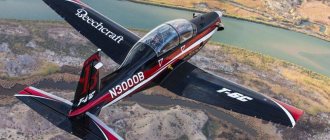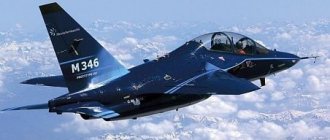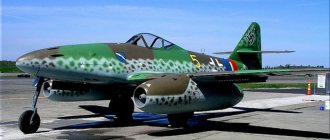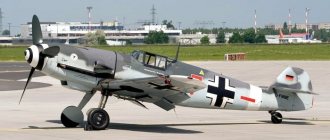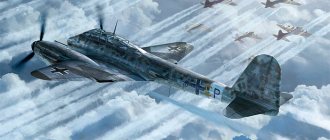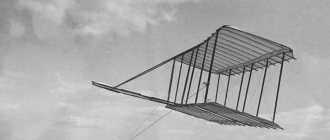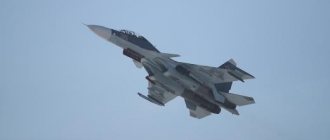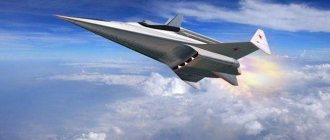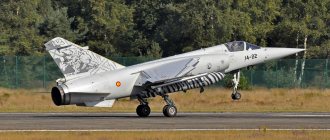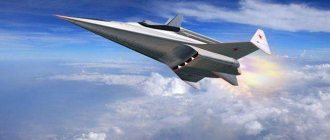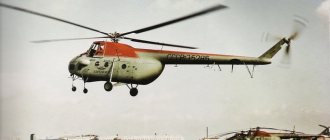The history of the creation of the Messerschitt (Bf) fighter - 109
By 1934, the German Heinkel He-51 fighter was already outdated and to replace it, the Luftwaffe announced a competition, in which Focke-Wulf and Heinkel were to take part. was not on this list, even moreover, Willy Messerschmitt was simply denied participation. However, he was not the kind of person who would give in to difficulties.
Messerschmitt had an excellent example - the Bf-108 sports aircraft . Having decided, on his own initiative, to create his own fighter under the designation Bf-109 , he based it on the Bf-108.
The prototype Bf-109V1 took to the air the very next year - on May 28, 1935, at the same time the new machine was nevertheless admitted to comparative tests, and in competition with the competition vehicles Ar-80V1, FW-159V1 and He-112V1, first “reached the semi-finals”, and then, in the fight against another favorite - a Henschel fighter, she won a landslide victory. In August 1936, during the XI Olympic Games in Berlin, the Bf.109 was first shown to the public, and in February 1937 its mass production began.
Sports aircraft Bf-108, progenitor of the Bf-109 fighter
It would be a mistake to believe that Messerschmitt created the “ideal aircraft”, which was produced from 1935 to 1945 and at the same time, even by the end of the war, remained completely modern and was distinguished by excellent flight characteristics. But we can definitely say that the true genius of the designers was that when creating the Bf-109, they endowed it with an amazing “margin of safety” and left such a foundation for future modernizations that was enough for the next ten years.
The Bf-109 fighter of the 1935 and 1945 models are two completely different machines, almost doubling (and in some parameters more than doubling) diverging in characteristics. It is not surprising, given the huge “circulation” of this aircraft of 30,573 copies produced (in terms of mass production, the Bf-109 ranks 2nd after the Il-2 attack aircraft and first among fighters) and the number of modifications exceeds three dozen.
In addition to Germany, the Bf-109 was produced under license in Austria, Hungary, Spain (until 1954!), Romania, and Czechoslovakia. In addition to the Luftwaffe, it was in service with the Air Forces of Bulgaria (until 1946), Hungary, Israel, Spain (until November 1965), Italy, Slovakia, Finland (until 1954), Croatia, Switzerland (until 1949), Yugoslavia.
b MYUVYUKE 1933 Ts. E B ONOSKPMSHU B RN BPEL B EBPNOE EFETSNDMSHU YANPEBMNBYUMHU "VEKKEMDF". LYUHMYU, ONKSVKHBIU NANGMYUVEMHE l-37, BYAINPE YALEMEMMNE MU Bf 108
(OPNGBKHYE "RYUITSM" GYUPEOKHKNYAE GYU YAYULNK╦RNL I K╦TSYNI PSYKH MELEZHYNI KERVKHZHSH schKKH aYUIMUNPM, BRNPNI FEMYKHMSH B LHP, YANBEPIKHBEI YPSTSNYABERMSHI ONK╦R), ASHKYU BE YAELYU MNBURNPYAYNI YNMYARPSYZHHEI: ZHEKEMNLERYUKKKHVEYAYHI LNMNOKYUM I MKHGYNPYUYAONKNFEMMSHL YPSHKNL H SAKHPYUCHYHLYUYAYAH. mu THPLE OYUPYUKKEKEMN BEKYUYAE ONYARPNIYU 6 SHYGELOKPNB (OPNRNRHONB, ЪBKЪCHYKHUYAKH OPEDYAEPKHIMSHLH LYUKHMYULH), OPEDMYUGMYUVEMMSHU DK SVYUYARKH B "vekkemdfe" 1934 Ts. oEPBYU LYUKHMYU Bf-108V1 ASHKYU NAKERYUMYU 13 KhChM 1934 Ts.
nM OPEDYARYUBKK YANANI YABNANDMNMEYASYKHI LNMNOKYUM I MHGYHL PUYAONKNFEMHEL YPSHKYU, SAKHPYUCHYHLKHYA TSKYUBMSHLH YARNIYULH YUYAYAH KH UBNYARNBSHL YNYARSHKEL, GYUPSHRNI VERSHPE ULEYARMNI YUAKHMNI. YaYULNKERSH OEPBNI OYUPRKHKH, MYUGBYUMMSHE Bf 108yu, YNLOKEYRNBUKHYAE 8-ZHKHKHMDPNBSHLH LNRNPYULH BNGDSMNTSN NUKYUFDEEMKH "UKHPR" ml 8U (225 K.Ya.) - GYU HYAKCHVEMHEL NDMN TsN SHCHYGELOKPYU, ONKSVKHBIETSN 6-ZHKHKHMDPNBSHI DBKHTSYUREKE "yuPTsSYA" As 17b (220 K.Ya). b YANPEBMNBYUMKHU OPKHMKKH SVYUYARKHE 4 Bf 108yu, ONYUGYUBKHE MEOKNUKHE PEGSKERYURSH. schRN ONASDHKN PEIUYALHMHYAREPYARBN YUBHYUZHHH B MYUVYUKE 1935 Ts. EMH HU B KCHTRBYUTTE B YUVEYARBE YABGMSHU.
ONYARYUBYKH OPEDYAPHIMSHU Bf 108b-0 MYUVYUKHYAE B KHCHKE 1935 Ts., YAEPHIMSHU - B DEYUAPE. bShOSYAY OPNDNKFYUKYA DN MYVYUKYU 1944 Ts. 5 HGTSNRNBHKH BN tPYUMZHHH ONYAKE BNIMSH.
b KCHTRBYUTTE YAYULNKERSH Bf 108B/D OPHLEMKKHYAE, TsKYUBMSHL NAPUGNL, B YUVEYARBE YSPEEPEYAYKHU. LYUKHMSH SCHRNTSN RHOYU OPKHDUBUKHYAE TsPSOOYUL KH SHCHAYYUDPYUL ANEBNI YUBKHYUZHHH, RYUAYUL KCHTRBYUTTE PUGKHVMSHU SPNBMEI. dK OPHLEMEMKH B yaEBEPMNI yuTPHYE VYUYARE YYULNKERNB ASHKYU LNDKHTHZHHPNBUMYU B BYUPKHYUMR Bf 108B-2/trop. RUYFE Bf 108 YAKSFHKH B YANYARYUBE R.M. "MELEZHYNI YUBHYUYAKSFASH" (Deutsche Luftdienst), TsDE OPHLEMKHYAE B PYUGKHVMSHU BIAONNLNTSYUREKEMSHU ZHEKYU. bYARPEVYUKHYAE "RYUITSMSH" KH B YUBKHYYYNKYUU, MN RYUL KH HYAONKEGNBUKH, OPEFDE BYAETSN, YUY YABGMSHE, YU ME SVEAMSHE.
Bf 108 DNBNKEMN LKHPNYN SHYYAONPRKHPNBUKHYAE. b VYUYARMNYARKH, B 1936 C. 6 Bf 108b-1 GYUYUGYUKH bbya bemtsphkh (B UNDE BNIMSH OPNRKhB yayap bemtspkhkh ONYARYUBHKH EY╦ MEYAYNKEIN “rYUITSMNB”). schRKH LYUHMSH YAKSFHKH B YUVEYARBE YABGMSHU OPH HYARPEAHREKEMSHU H ANLAYUPKHPPNBNVMSHU TsPSOOYUU.
12 Bf 108b-1 ONKSVKHKYU chTSNYAKYUBKH. xU PUYAOPEDEKKHKH OH YABGMSHL SCHYAYUDPHKEL, Yu 4 YAYULNKERYU OPHLEMKKHYAE DK ONDTSNRNBYKH OKKNRNB KHYARPEAHREKEY Bf 109e. ONYAKE ONPUFEMKH CHTSNYAKYUBKHH B YOOPEKE 1941 Ts. eY╦ VERSHPE Bf 108 ONKSVKHKH B 1944 Ts. bbya bBEIZHYUPHKH ONKSVKHKH 12 Bf 108b-1 B 1939 Ts., SHYAOXYURKHPS KH DN MYVYUKYU 50-U TSTS.
10 Bf 108b-1 "B OYUYERE" I HYARPEAHREKILH Bf 109e B 1940 Ts. ONYARYUBHKH pSLSHMHKH. xU PUYAOPEDEKHKH LEFDS 111-I X 112-I YAB'GMSHLH SHCHAYYUDPHKE'LH, OPHDUMMSHLH 1-LS X 2-LS YUBKHYINPOSYYUL. mu RYUHU FE "OYUYERMSHU" SYAKNBKHU B 1941 Ts. ONKSVKHKYU 6 Bf 108b B 1941 Ts. aNKTSYuPHY.
dK HYAOSHRYUMKHI B 1936 Ts. NDHM Bf 108b YSOKHKYU ъONMHЪ, YU B 1940 Ts. - DBYU YAYULNKERYU ONYARYUBHKH B yayap. yayu B 1939 Ts. YSOKHKH (HKH YUPEMDNBUKH) RPH Bf 108b DKЪ MSFD YABNHU BNEMMNTSN X BNEMMN-LNPAYNTSN YURRYUYE B aEPKKHME (NMH ONKSVHKH NANGMYUVEMHE XC-44). ONYAKE BYARSOKEMKH YAYU B BNIMS B DEYUAPE 1941 Ts. SHCHRKH LYUKHMSH ASHKKH YNMTKHYAINBYUMSH TSEPLUMKHEI. nDKhM Bf-108b I 1939 Ts. DN MYUVYUKYU 50-U TsTs. YAKSFHK B bbya vHKH.
VERSHPE TSPYUFDUMYAYKHU Bf 108b, SHYAOXYURKHPNBUYUBKHYYA B BEKKHYNAPHRYUMKHH, ONYAKE MYUVYUKYU BRNPNI LKHPNBNI BNIMSH ASHKH YNMTKHYAYNBUMSH APKHRYUMYAYHL OPYUBKHREKEYARBNL, X MEINRNNPNE BPEL HYAONKEGNBUKHYAE yNPNKEBYAYHLH bbya OND NANGMYUVEMHEL "LEYAYAEPLHRR" "schKDNM". UNR YAYULNKERSH YAVKHRYUKHYAE YAYULSHLH YAYNPNYARMSHLH YABGMSHLH LYUHMYULH, HU OPKHKNYAE YAMRE I SHYAOXYURYUZHHH GH-GYU PKHYAYU YAOSRYURE "schKDNMSH" I Bf 109.
b ONYAKEBNEMMNE BPEL RPNTEIMSH "RYUITSMSH" SHYYAOXYURKHPNBUKHYAE bbya veUNYAKNBUYHH (OND NANGMYUVEMHEL y-70), onKEH, mNPBETSKHH. bN tPYUMZHKH DKHREKEMNE BPEL YAKSFHKH YUY RPNTEIMSHE Bf 108, RYU X YAYULNKERSH “mNPD” 1000/1001/1002 - ONYAKEDMKHE SHYYAOXYURKHPNBUKKHYAE X bbya, X LNPAYNI YUBKHYUZHHEI.
YaYULNKER LEYAYAEPLHRR Bf-108 NYUGYUKYA BEYAELU OEPEDNBNI B REUMNKNTSKHVEYAYNL X YUSCHPNDKHMYULHVEYAYNL NRMNYEMHYU YNMYARPSYZHHEI.
hLEMMN SHCHRYU YAONPRKHBMN-YABGMYU LYUKHMYU LNFER ON ONKMNLS OPYUBS YAVKHRYUREYA OPEDIYARBEMMKHYNL GMYULEMHRNTSN HYARPEAHREK Bf-109. xMREPEYAEM RNR TUYR, VRN Bf 108, KKH ONYAKEBNEMMSHE Nord 1000, HYAONKMKKH PNKH "LEYAYAEPLHRR 109" B GYUOYUDMSHU THKELYUU. lNDHTHYUZHHH :
| Bf 108A | OEPBYU YAEPKHIMYU LNDKHTHYUZHKH. |
| Bf 108B | B NRKHVHE NR Bf 108yu BLEYARN UBNYARNBNTsN YNYARSHK OPHLEMEMN YNKEYAN. sBEKKHVEM PYUGLYU YPSHKYU, BMEYAEMSH MEINRNPSHE DPSTSKHE KHGLEMEMKH. mu RPEU OPEDYAPHIMSHU Bf 108 SYARYUMNBKEMSH DBKHTTSUREKH "uHPR" ml 8U (225 K.Ya), MU YAEPHIMSHU - 8-ZHKKHMDPNBSHE "yuPTsSYA" As 110ya (240 K.Ya). bSHOSYAYUKYUYAE TsPYUFDUMYAYU LNDKHTHYUZHKH Bf 108b-1 X BNEMMYUJ Bf 108b-2, NRKKHVYUBYUJYANYARYUBNL NANPSDNBYUMKH X NRYASRYARBHEL BNGLNFMNYARKH YAYKYUDSHBYUMKH Kommersant YPSHKYU. bSHOSYAY ONYAKEDMEI MYUVYUKYA B 1938 Ts. OYUPYUKKEKEMN I TSPYUFDUMYAYHL BYUPKHYUMRNL, YU I 1939 Ts. BSHOSYAYUKYA RNKEIN Bf 108b-2. b NAYEI YAKNFMNYARKH MU GUBNDE "LEYAYAEPLHRR" B yUSTSYASPTSE KhGTSNRNBKEMN 601 YAYULNKER (DN 1942 Ts.), Yu MU OPEDOPPHЪRKHH SNCAN B ke lChPN (tPYUMZHKH) - 81 LYUKHMYU B 1942-1 943 CC. |
| Bf 108ya-1 | EDKHMYARBEMMSHY SHYGELOKP, ONKSVKHBKHI 7-ZHKKHMDPNBSHI LNRNP BNGDSMNTSN NUKYUFDEMHYA "YAHLEMYA" Sh 14yu (160 K.Ya). |
| Bf 108D-1 | DBKHTSYUREKE As 10R (240 K.Ya), MNBSHI, ANKEE MYUDEFMSHI YARYUPREP, SYANBEPEMYARBNBUMMYU YAKHYARELYU BEMRKJKZHKH YUAKHMSH KH PJD DPSTSKHU KHGLEMEMKHI. mu GUBNDE B yuSSTSYASPTS BSHOSYEMYU 131 LYUKHMYU, B kE lCHPN - 80 (B 1943-1944 Tsts.). |
| lE 208 | DUKEMEEEE PUGBHRHE YAYULNKERYU. LYUHMYU ONKSVHKYU YUYAYAH I MNYANBSHL YNKEYANL. b 1944 Ts. |
| Nord 1000/1001/1002 Pingouin | — YAYULNKERSH ONYAKEBNEMMNI TPYUMZHSGYAYNI ONYARPNIYKH. "mNPD" 1000 YNLOKEIRNBYUKHYAE LNRNPYULH As 10R, "mNPD" 1001 - 6-ZHLKHMDPNBSHLH "peMN" 6Q-11 (235 K.Ya), "mNPD" 1002 - "peEMN" 6Q-10 (240 K.Ya). |
| cru: |
| lNDHTHYUZHH | Bf.108B |
| pYUGLUU YPSHKYU, L | 10.50 |
| dKKhMYu, L | 8.30 |
| bSHYANRYU, L | 2.30 |
| OKNYYUDE YPSHKYU, L2 | 16.40 |
| I love it, JC | |
| OSYARNTSN YYULNKERYU | 880 |
| LYUYAHLYUKEMYU BGKERMYU | 1385 |
| RHO DBKHTSUREK | 1 od Argus As 10C |
| lnymnyare, K.Ya. | 1 U 240 |
| LYUYAKHLYUKEMYYAINPNYARE, YL/V | 300 |
| yPEIYEPYAYU YAYNPNYARE , YL/V | 262 |
| oPUYRHVEYAYU DUKEMNYARE, YL | 950 |
| oPUYIRKHVEYAYKHI ONRNNKNY, L | 4800 |
| ShYKHOYUF, VEK | 1 |
| ONKEGMYU MYUTSPSGYU: | 3 OYYYYUFHYU |
| bottom. KhMTNPLYUZHKH: |
| VEPREF "Messerschmitt Bf.108 Taifun (1)" VEPREF "Messerschmitt Bf.108 Taifun (2)" VEPREF "Messerschmitt Bf.108 Taifun (3)" tNRNTsPYUTKHH: | Bf.108V-1 |
| Bf.108A-1 | |
| Bf.108B-0 | |
| Bf.108B-1 | |
| Bf.108B-1 | |
| Bf.108B-1 | |
| Bf.108B-1 HYAONKEGNBUBUKHYYUMTSKKHVYUMYULH | |
| bBEIZHYUPYAYKHI Bf.108B-1 | |
| ndХМ ХГ Bf.108B-2 HYAONKEGNBUBUKHYYULEPHYUMZHYULH | |
| Bf.108B-2 | |
| Bf.108B-2 | |
| Bf.108ya-1 | |
| Bf.108D-1 | |
| Bf.108D-1 | |
| yYuAkhmyu Bf.108B-1 | |
| yUAHMYU OHKNRYU Bf.108B-1 | |
| BEMTSEPYAIKHI Bf.108B-1 |
IWELSH:
| Bf.108B |
| YNLONMNBNVMYU YAUELYU |
| YNLONMNBNVMYU YAUELYU |
bYUPHYUMRSH NYPYYAYH:
| Bf.108B |
| Bf.108B |
| Bf.108B-1 (XC-44) |
| Bf.108B-1 |
| Bf.108B-2/trop |
| YaOHYANY HYARNVMKHYNB: |
| Elbert H., Kaise J., Peters K. Willy Messerschmitt - Pionier Luftfahrt und des Leichtbaues Wydatnictwo Militaria. Seweryn Fleischer. Messerschmitt Bf 108 Taifun ATL. Petr Kolmann. Messerschmitt Bf 108 Taifun Close-Up. Thomas H. Hitchcock. Taifun dNMYUKED d. ONKMYU SHCHMZHHYKNOEDH LHPNBNI YUBHYUZHH: YaYULNKERSH X BEPRNKERSH XX YARNKERH |
sTSNKNY MEAYU. 2015
Characteristics of Messerschmitt Bf-109
A country:GermanyType:FighterYear of issue:1943 (1935)Crew:1 personEngine:DB-605DM, 1800 hp (Jumo-210Ga, 680 hp) Maximum speed:605 km/h, at the ground 700 km/h, at altitude (408 km/h and 463 km/h)Practical ceiling:12500 m (8200 m)Range of flight:570 km (690 km)Empty weight:2755 kg (1580 kg)Maximum take-off weight:3400 kg - normal take-off (2050 kg)Wingspan:9.92 m (9.87 m)Length:9.02 m (8.7 m)Height:3.4 m (3.4 m)Wing area:16.02 km.m. (16.35 sq.m.) Weapons:1x 30 mm cannon, 2x 13.2 mm machine guns, (3x 7.92 mm machine guns).
The characteristics are given for the Bf-109K-4 model (one of the latest models), comparative characteristics for the Bf-109B-2, the first production model, are indicated in brackets
1942: peak form on all fronts.
0
And then we have the year 1942. The year when the Luftwaffe reigned supreme on the fronts, and it was very difficult to oppose anything. But in essence, it was a war between aircraft engine manufacturers. As soon as Daimler-Benz rolled out a new engine, a new aircraft was built around it. And in 1942 we are talking about the Bf 109G or Gustav. In general, I consider this car to be the peak for Messerschmitt. So the plane was good. Engine, afterburner, MG 131 heavy machine guns of 13 mm caliber finally appeared, a 30 mm MG-108 cannon was installed in the cylinder camber, five-point fighters with two outboard guns in containers under the wings...
0
But first, the numbers. And again the Messerschmitt is in the middle. There are faster ones, and there are longer ones. Maneuver in the vertical - the Yak will definitely win. We’re not even talking about the “dog dump.” So the plane is good, but it is just good and simply cannot pretend to be an aerial scarecrow.
0
Many will now say: why isn’t “Cobra” in the table? It's simple: the plane was also not trivial, and was used by ours without regard to performance characteristics, about which much has already been written. Plus, it makes direct sense to look at the dynamics of opponents. But if you look at the numbers (I especially emphasize this), the G6 is clearly inferior to the same Spitfire. Meanwhile, the Yak-9, which does not shine in terms of performance characteristics, could quite normally fight against the Bf 109G, which will be discussed specifically in the results.
Combat use of the Messerschitt (Bf) fighter - 109
First used in Spain in December 1936. By September 1939 it was the main fighter of the Luftwaffe. Participated in all major operations of World War II on all fronts as a day and night fighter, fighter-bomber, and tactical reconnaissance aircraft.
From October 1944, Romanian Bf-109Gs were used against the Germans. Israeli S-199s took part in the war with Egypt in 1949. Spanish HA-1112M.1L took part in the fighting in Western Sahara in 1958.
Description of the aircraft design
The Bf.109 was an all-metal monoplane with a low wing and a single fin. The fighter cabin is closed, and on high-altitude modifications it is sealed. The wing is single-spar, thinner and shorter than on most fighters developed in the 30-40s.
The aircraft is equipped with retractable landing gear. The main struts fold outward after takeoff—no one else has used a similar design. In flight, the wheels are placed in the wing niches. For some unknown reason, these niches were not equipped with fairings until 1944.
The Messerschmitt Bf.109 was equipped with various liquid-cooled engines with a small aerodynamic profile. The power of the power plant by the end of the war exceeded 2000 horsepower.
